Experience has surely taught us that it is impossible to decide in advance whether even the most abstract speculations may not eventually prove extraordinarily helpful in practice.
Marc Bloch (1886−1944), “Introduction,” The Historian’s Craft (1941), trans. Peter Putnam (New York, NY: Knopf, 2004), 8.
The new is not always easy to understand.
Paul Goldberger, “Architectural Criticism in the Age of Twitter,”
lecture, National Building Museum, November 27, 2012.
What is essential knowledge for architecture, and how is that knowledge best obtained?1 Those questions guide the thinking of every ambitious designer and every conscientious design school curriculum committee. Knowledge2 is information, skills, or awareness pertaining to a particular subject. It can be practical or theoretical, held by an individual or shared. Essential3 can mean fundamental, absolutely necessary, or both. Therefore, essential knowledge is information, skills, or awareness directed to some purpose or end; it comprises core principles as well as new imperatives.
To define essential knowledge for architecture, or for any discipline, the typical approach is to describe an ideal of practice, identify knowledge essential to that ideal, and structure opportunities to obtain said knowledge efficiently. Of course, understandings of essential knowledge can vary over time. As disciplines adapt to new circumstances and demands, ideals of practice change — sometimes quickly so. For designers, keeping up to date might require learning new modeling software, addressing changes in safety codes, perusing a recent scientific study, or getting more hands-on experience. For academic programs, it means offering courses variously fundamental and forward-looking while eliminating those that have become outmoded; when efficiency is a priority, currency is in part a function of streamlining.
In those situations, non-essential means beyond what is fundamental or necessary, which connotes lack of relevance. Yet, as a condition of excess, non-essential can also mean broadening, enriching, clarifying, and a host of related functions. Understood in that way, essential and non-essential are distinguished not in terms of relevance but by different orientation relative to a thread of purpose. Essential knowledge is keyed to an idea of efficient progress towards a specific end. In other words, it is linear4 and determinate.5 Alternatively, non-essential knowledge is lateral6—literally, “of, at, toward, or from the side or sides.” Non-essentials distract7, digress8, or diverge9 from the thread of purpose, which explains why aspiring specialists and curriculum committees tend to avoid them.
An idea of essential and non-essential as correlates, rather than as contraries, is conveyed in the phrase “In essentials, Unity; in non-essentials, Liberty; and in all things, Charity” (“In necesariis Unitatem, in non-necessariis [also rendered as dubiis, uncertain things] Libertatem, in utrisque Charitatem”), the slogan of manifold Christian movements and scholars since the seventeenth century and a phrase often falsely attributed to St. Augustine. In that formulation, essentials unify because they define a common core. In contrast, non-essentials (or uncertain things) have no bearing upon the core and can therefore be tolerated, but they also diversify and enrich, which makes them a valued part of “all things.” Essential and non-essential are correlates under the aegis of compassion. In a similar way, non-essentials in education are elective courses through which students develop breadth or voluntary specialization. In that way, topics not considered essential from a disciplinary perspective are recognized and accommodated within curricula — that is, so long as they complement essentials without compromising the integrity of the course of study.
Disciplinary knowledge is typically conceived as if a coherent10 body.11 In professional culture, the “body of knowledge” encompasses everything a practitioner needs to know, as determined by the association providing oversight. The integrity of those two bodies — the professional association and its body of knowledge — depends on two essential lines: the sequential process through which core knowledge is obtained, leading to mastery, and the outer margin or “front12 line,” where limits are tested and new knowledge is formed. Those lines constitute disciplinary knowledge as a sort of conceptual territory. As in political and military culture, the centerline guarantees the principles or norms through which disciplinary stability is ensured, while the front line represents the most progressive position. Changes in either place impact the scope and meaning of the whole. Consequently, the integrity of the body — the association and its knowledge — is defended most strenuously at center and edge.
Innovative theorists and practitioners have long looked to the edge when challenging disciplinary norms and imagining new possibilities for their work. The conventional strategy is to lay claim to the front line — again, the most progressive position — while drawing upon other fields: one foot in, one foot out. Yet, locating progressive theory and practice at the margins only affirms the corporate13 model of disciplinary knowledge, for which the front line is both a seedbed and a safeguard.
In recent years, growing interests in complexity,14 emergence,15 and resilience16 have subverted the traditional bases of the professional body of knowledge. In architecture, landscape architecture, and a host of related fields, new thinking about ecology17 and sustainability18 have been central to that turn, supplanting linear succession and ideal forms as models through which to understand both nature and design. Linear disciplinary frameworks prioritize efficiency and uniformity leading to ideal solutions. Grounded in causality, they pretend to know the future by charting past and present. But there are no guarantees, and such linear thinking leads astray by failing to lead astray. Witness the Titanic. And the Edsel. Linear frameworks are compromised by contingency19 because linear progress is not, in truth, progressive.20
In contrast, lateral thinking sidesteps the narrowing scope and critical (i.e., distancing) logic of linear thinking in order to explore proximate21—and therefore relevant22—uncertainties and potentials. Lateral thinking eschews essential knowledge and solves problems “by an indirect and creative approach, typically through viewing the problem in a new and unusual light.”23 In other words, it is purposeful, but it diverges from the conventional approach. Lateral thinking accepts the present as a condition we cannot escape and is therefore better suited than linear projections to the future-we-cannot-know. The contingent nature of that future guarantees that some forms of knowledge not presently considered essential will eventually become so, and vice versa. Consequently, all forms of knowledge, however characterized, carry potential significance.
In contemporary design, center and the edge are no longer the exclusive sites of knowledge formation. Instead, meaningful work is being pioneered laterally, in unexpected yet relevant ways. That diffusion of capability and significance has redefined the terms24 of disciplinarity just as guerrilla tactics once transformed the experience of war. The center has been decentered. The margin has been marginalized. The front line is no longer a line. In the past, the military front line was literally a line — for example, the trench systems of the Western Front during World War I — but conflict, like innovation, is now pervasive. It can emerge anywhere, at any time, and at any scale. The ability to effect broad change through discrete gestures — for example, deploying a building or park to catalyze urban economic redevelopment — was formerly the preserve of ‑crats25 and ‑archs26: autocrats, bureaucrats, and technocrats; monarchs, oligarchs, and (st)architects.27 Now the novice has that capability, operating from the side lines. The start-up is both an upstart and a star.
Prioritizing non-essential knowledge as a path to new architecture means eschewing linear frameworks in favor of lateral methods, diverging from the conventional path without losing relevance: for example, by repeating, reversing, or returning. Categories of non-essential knowledge might include the previously forgotten, the currently undervalued, the generally misunderstood, or the not yet recognized. Lateral methods are idiosyncratic28 but not arbitrary29; in fact, they are predicated on relevance, as they linger30 on matters at hand rather than abandoning them for some distant, preconceived goal. Inefficient relative to linear conventions, such approaches are well suited to contemporary interests in complexity, emergence, and resilience, which prioritize versatility and adaptability.
In this new architecture, expertise is demonstrated through the ability to generate many distinct yet plausible responses, rather than only one ideal solution, to any given problem. Such virtuosity is a function of resourcefulness. Within education, that sort of open-endedness is at odds with the well-intentioned yet narrowing and reductive culture of learning objectives, outcomes, and assessments, in which “effective”31 teaching means declaring in advance what students should know and guiding them to that point. Educators can, and likely will, continue to teach fundamentals in such a way, presenting education as transmission of a useful body of knowledge. But, in truth, they do not know, nor can they know, what students will actually do with that knowledge, if they make use of it at all. A more reasonable approach is to equip students for an open range of possibilities — the future-we-cannot-know. And that calls for a new way of thinking about disciplinary knowledge, one that abandons the corporate model defined by essential lines in favor of something more distributed and abstract: not a form but a condition or quality; a mood; an attitude, sensibility, or ethic. Less a modus operandi than a modus essendi—a way of being. Not linear and determinate but lateral and indeterminate. Non-essential as both fundamental and necessary — and therefore new.
Urbana Land Arts (Chris Carl), Inter-Urban (2012), with Bobby Zokaites, Paul Howe, and Sutton Demlong. Recovery, restoration, and reuse of a derelict railroad crane, Shady Rest (near Monticello), Bondville, and Heartland Pathways right-of-way between Monticello and Cisco, Illinois. All photographs © Chris Carl.

Derrick crane manufactured by Fairmont Railway Motors, Fairmont, Minnesota, for railroad right-of-way (ROW) maintenance tasks. This crane was discovered at Shady Rest Trestle, Piatt County, Illinois.
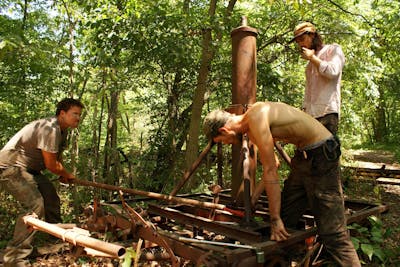
Because of its remote location, the Fairmont was carefully dismantled on site and manually hauled from the woods piece by piece.

The 13' boom arm was carried over the Sangamon River via Shady Rest Trestle, while the carriage required a longer route through Shady Rest Nature Preserve.
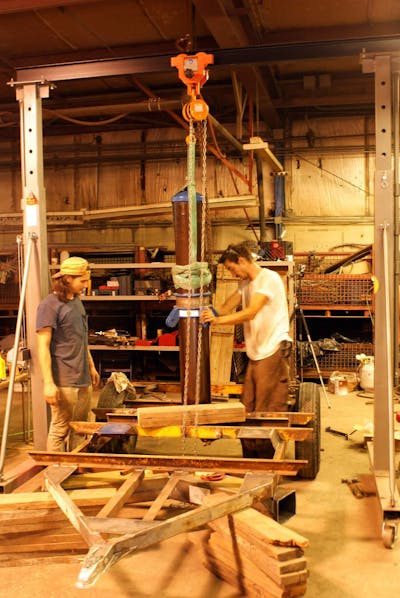
The Fairmont was painstakingly refurbished and brought back to working order, although it was modified for paved roads rather than railroads. The modifications entailed the addition tires and outriggers for stability.
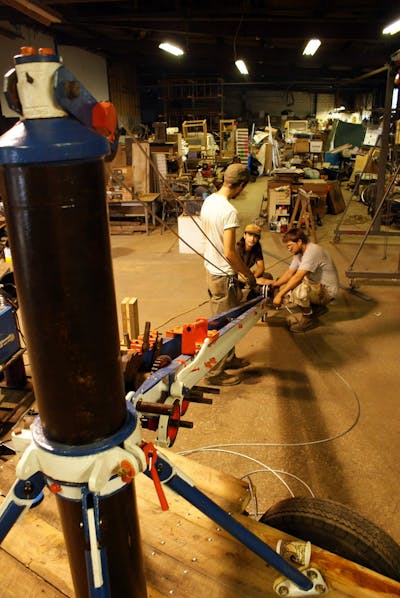
The team discusses how to re-string the boom arm with new stainless steel cable.
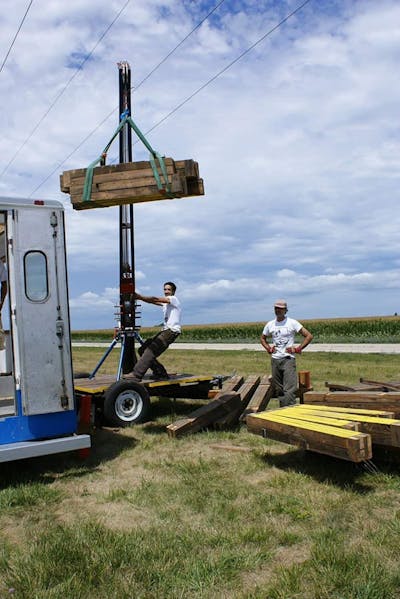
The Fairmont became a critical component of the public artwork Inter-Urban, located in Amenia, Illinois.
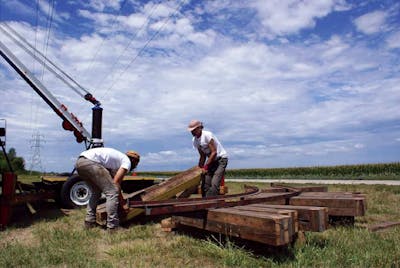
Wood salvaged from a demolished grain elevator was used to build a portable bench assembled on a decommissioned railroad owned by Heartland Pathways.
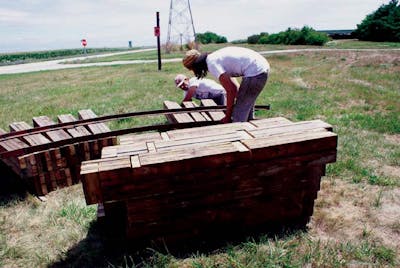
The bench was designed to be assembled without fasteners and by stacking on, and locking into, steel tracks.

Inter-Urban was temporarily located in Amenia, Illinois, on a decommissioned railroad ROW in the shadow of the Amenia elevator (now destroyed). The work was built using salvaged elevator wood, a derrick crane, and a repurposed potato chip delivery truck in collaboration with David Monk and Heartland Pathways.
Review
By Mary Jane Jacob
David Hays’s reflection — and his call for openness — arrives at essential questions of being: how do we think, what is it to sense discovery, how do we move forward in what we do, making a better building, solution, and future? It gets to the essence of who we are.
The American philosopher John Dewey said that “(i)ntuition alone articulates in the forward thrust of life and alone lays hold of reality.” (Time and Individuality, 1940). Intuition grabs hold of what we know and — driven by a hunch, propelled by some curiosity, based on a gut feeling — takes us to another place of knowledge. That may not be the final step in the process, but it is nearly always a necessary evolutionary step. Abandoning philosophy’s age-old quest for a world of ideals, Dewey was firmly rooted in this world, and he knew that the reality in which we live pushes us to learn beyond the limits of the classroom because our environment is always changing.
So, how does education prepare us for that? Dewey hated rote learning, with its fixed rules, probably as much as he hated categories that fixed the boundaries around disciplines. (No wonder he was the leading figure in Progressive Education.) These structures emerged as part of man’s desire for certainty — our innate need to have the security of answers. Well, forget that, said Dewey. It’s all about questions — and the questions change. This was the hallmark of the modern era he helped navigate for American society: uncertainty was inevitable on the street and in the universe, by then proven by science not to be eternal and unchanging. There are no guarantees, as Hays puts it.
Since circumstances are continuously changing, Dewey thought, so too must be the perspectives we bring to them. Our consciousness must expand and knowledge must grow. This essential way of being in the world, as he saw it, might be developed in school, but it includes all our experiences. Knowledge needs to carry us to places we do not yet know. If we are truly alive and conscious in the world, we can’t feed off a fixed body of knowledge. Anyway, that would be boring; we’d be less than fully alive. But this expansion is not so much to be new, to do the new thing, but to feel what we do anew as we embody it.
So, an essential skill is framing the right question: what lens can give insight into a problem, and how do we then gain knowledge to further the inquiry? There, Dewey found art very useful because it is a creative process. Dewey knew that, in every true experimental process, you must give yourself to an unfolding process, holding the final outcome in suspension until the process has been thoroughly lived, or else there is no real discovery. Now we banter about innovation everywhere today, but I’ll resist using this word that has come to be tied so much to the hubris of the promoting maker. The point here for education — and for Dewey — is that when we go through a creative process, we discover something for ourselves, hit upon knowledge out there for the taking, maybe known and then forgotten, and use it anew.
Following a creative process is something Dewey thought scientists and artists share: they make discoveries. He didn’t mention architects, though he did think that, through their work, “human life itself is also made different, [though] in ways far beyond the intent or capacity of foresight of those who constructed the buildings” (Art as Experience, 1934). Their creative process is what Hays calls lateral thinking. Walter Hood calls it speculative knowledge, and, valuing that, it’s no wonder that this seasoned landscape design professional felt compelled to go back school to get a MFA.
Speculative thinking is the way Hood operates personally as he carries out his work professionally — but his process is not considered professional “best practice.” So, coming to the School of the Art Institute — where even architects are in the terrain of art — was a way for Hood to honor the ways he knows, to acknowledge knowing from experience, practices that hold, as Hays cites, potential significance. Then he could shift the conventions of the fields of architecture, landscape, and environmental design, at least for himself in his own practice. And, like for Hays, it was essential to demonstrate that speculative knowledge or lateral thinking is neither a diversion nor mere diversification, but a means of attaining insight into a given situation and bearing practical results (perhaps even more efficiently than Hays allows for in his text).
I undertook a curatorial research project some time ago by setting it up as a shared inquiry with fifty other museum professionals; we set out to look at the relationship between contemporary art and Buddhism.32 We could have dwelled on lots of art that incorporates Buddhist imagery or employs meditative practice, but locating such signifiers as representations of Buddhism was not the goal. In fact, we had no goal, no preconceived idea of the outcome, though a myriad of outcomes unfolded and continue still. Rather, we were open. (And, as professionals, arriving at being open was hard — it took some practice!) Our aim was to understand the relationship of today’s art and artists to Buddhism and what that offered audiences. We found that the way artists worked — developing laterally, thinking speculatively — possessed the precision of a Zen archer, and perceiving in that way, through their work, enables us to be open. Teaching and modeling openness is the way inside the creative mind — and who would not want to go there?
Notes
1
This essay was first published as the introduction to (Non-)Essential Knowledge for (New) Architecture [306090 Books 15], ed. David L. Hays (New York, NY: 306090; Princeton Architectural Press, 2013), 16 – 23.
2
knowledge: “Middle English (originally as a verb in the sense ‘acknowledge, recognize,’ later as a noun): from an Old English compound based on cnāwan (see know); know: Old English cnāwan (earlier gecnāwan) ‘recognize, identify,’ of Germanic origin; from an Indo-European root shared by Latin (g)noscere, Greek gignōskein, also by can(1) and ken.” This and all subsequent etymological notes and quoted definitions are from The New Oxford American Dictionary, second edition (New York, NY: Oxford University Press, 2005), published online as Oxford Dictionaries (April 2010).
3
essential: “Middle English (in the sense ‘in the highest degree’): from late Latin essentialis, from Latin essentia.”
4
linear: “mid 17th century: from Latin linearis, from linea ‘a line’ (see line(1)); line(1): Old English līne ‘rope, series,’ probably of Germanic origin, from Latin linea (fibra) ‘flax (fiber),’ from linum ‘flax,’ reinforced in Middle English by Old French ligne, based on Latin linea.”
5
determinate: “late Middle English: from Latin determinatus ‘limited, determined,’ past participle of determinare (see determine); determine: “late Middle English: from Old French determiner, from Latin determinare ‘limit, fix,’ from de- ‘completely’ + terminare ‘terminate.’”
6
lateral: “late Middle English: from Latin lateralis, from latus, later- ‘side.’”
7
distract: “late Middle English (also in the sense ‘pull in different directions’): from Latin distract- ‘drawn apart,’ from the verb distrahere, from dis- ‘apart’ + trahere ‘to draw, drag.’”
8
digress: “early 16th century: from Latin digress- ‘stepped away,’ from the verb digredi, from di- ‘aside’ + gradi ‘to walk.’”
9
diverge: “mid 17th century: from medieval Latin divergere, from Latin dis- ‘in two ways’ + vergere ‘to turn or incline.’”
10
coherent: “mid 16th century (in the sense ‘logically related to’): from Latin cohaerent- ‘sticking together,’ from the verb cohaerere (see cohere); cohere: “mid 16th century: from Latin cohaerere, from co- ‘together’ + haerere ‘to stick.’”
11
body: “Old English bodig, of unknown origin.”
12
front: “Middle English (denoting the forehead): from Old French front (noun), fronter (verb), from Latin frons, front- ‘forehead, front.’”
13
corporate: “late 15th century: from Latin corporatus, past participle of corporare ‘form into a body,’ from corpus, corpor- ‘body.’”
14
complex: “mid 17th century (in the sense ‘group of related elements’): from Latin complexus, past participle (used as a noun) of complectere ‘embrace, comprise,’ later associated with complexus ‘plaited’; the adjective is partly via French complexe.”
15
emergence: “mid 17th century (in the sense ‘unforeseen occurrence’): from medieval Latin emergentia, from Latin emergere ‘bring to light’ (see emerge); emerge: “late 16th century (in the sense ‘become known, come to light’): from Latin emergere, from e- (variant of ex-) ‘out, forth’ + mergere ‘to dip.’”
16
resilient: “mid 17th century: from Latin resilient- ‘leaping back,’ from the verb resilire (see resile); resile: “early 16th century: from obsolete French resilir or Latin resilire ‘to recoil,’ from re- ‘back’ + salire ‘to jump.’”
17
ecology: “late 19th century (originally as oecology): from Greek oikos ‘house’ + -logy [“combining form 1 (usually as ‑ology) denoting a subject of study or interest.”].”
18
sustain: “Middle English: from Old French soustenir, from Latin sustinere, from sub- ‘from below’ + tenere ‘hold.’”
19
contingency: “mid 16th century (in the philosophical sense): from late Latin contingentia (in its medieval Latin sense ‘circumstance’), from contingere ‘befall’ (see contingent); contingent: “late Middle English (in the sense ‘of uncertain occurrence’): from Latin contingere ‘befall’, from con- ‘together with’ + tangere ‘to touch.’ The noun sense was originally ‘something happening by chance,’ then ‘a person’s share resulting from a division, a quota’; the current sense dates from the early 18th century.”
20
progressive: “early 17th century: from French progressif, -ive or medieval Latin progressivus, from progress- ‘gone forward,’ from the verb progredi (see progress); progress: “late Middle English (as a noun): from Latin progressus “an advance,” from the verb progredi, from pro- “forward” + gradi “to walk.”
21
proximate: “late 16th century: from Latin proximatus ‘drawn near,’ past participle of proximare, from proximus ‘nearest.’”
22
relevant: “early 16th century (as a Scots legal term meaning ‘legally pertinent’): from medieval Latin relevant- ‘raising up,’ from Latin relevare.”
23
lateral thinking: term coined by Edward de Bono in 1966.
24
term: “Middle English (denoting a limit in space or time, or (in the plural) limiting conditions): from Old French terme, from Latin terminus ‘end, boundary, limit.’”
25
-crat: “from French -crate, from adjectives ending in -cratique (see –cratic): ‑cratic: “from French -cratique, from -cratie (see –cracy); ‑cracy: “from French -cratie, via medieval Latin from Greek -kratia ‘power, rule.’”
26
-arch: “late Middle English: from late Latin -archa, from Greek arkhein ‘to rule.’”
27
architect: “mid 16th century: from French architecte, from Italian architetto, via Latin from Greek arkhitektōn, from arkhi- ‘chief’ + tektōn ‘builder.’”
28
idiosyncratic: “late 18th century: from idiosyncrasy, on the pattern of Greek sunkratikos ‘mixed together’; idiosyncrasy: “early 17th century (originally in the sense ‘physical constitution peculiar to an individual’): from Greek idiosunkrasia, from idios ‘own, private’ + sun ‘with’ + krasis ‘mixture.’”
29
arbitrary: “late Middle English (in the sense ‘dependent on one’s will or pleasure, discretionary’): from Latin arbitrarius, from arbiter ‘judge, supreme ruler,’ perhaps influenced by French arbitraire.”
30
linger: “Middle English (in the sense ‘dwell, abide’): frequentative of obsolete leng ‘prolong,’ of Germanic origin; related to German längen ‘make long(er),’ also to long(1).’”
31
effective: “late Middle English: from Latin effectivus, from efficere “work out, accomplish” (see effect); effect: “late Middle English: from Old French, or from Latin effectus, from efficere ‘accomplish,’ from ex- ‘out, thoroughly’ + facere ‘do, make.’”
32
See Mary Jane Jacob, “In the Space of Art,” in Buddha Mind in Contemporary Art, co-edited with Jacquelynn Baas (Berkeley, CA: University of California Press, 2004): 164 – 169.
- Tags
- architectureknowledge
Biographies
David L. Hays is co-editor of Forty-Five, Associate Head of the Department of Landscape Architecture at the University of Illinois at Urbana-Champaign, and founding principal of Analog Media Lab. Trained in architecture and history of art, his scholarly research explores contemporary landscape theory and practice, the history of garden and landscape design in early modern Europe, interfaces between architecture and landscape, and pedagogies of history and design. Hays is the editor of Landscape within Architecture (2004) and (Non-)Essential Knowledge for (New) Architecture (2013), both by 306090/Princeton Architectural Press. His essays have appeared in a wide range of journals — including Harvard Design Magazine, PLOT (City College of New York), Eighteenth-Century Studies, The Senses and Society (Oxford), Matéricos Perifericos (Rosario, Argentina), Tekton (Mumbai), and Feng jin yuan lin and Landscape Architecture China (Beijing) — and as chapters in numerous books. As a designer, Hays’s work explores the production of environmentally responsive objects using low-cost, low-tech materials. With particular interests in dynamic systems, environmental phenomena, and craft, his process crosses lateral thinking and intuition with grounded experiment. Email: dlhays@forty-five.com
Mary Jane Jacob is Professor of Sculpture and Executive Director of Exhibitions and Exhibition Studies at the School of the Art Institute of Chicago. Before coming to SAIC, she served as Chief Curator of the Museums of Contemporary Art in Chicago and Los Angeles. As a curator, writer, and educator, Jacob’s practice is rooted in the nature of artmaking and art experience with an emphasis on site-specific public work and social engagement. Exhibitions and programs organized by Jacob include Places with a Past (1991) and Places with a Future (2005), both at the Spoleto Festival USA in Charleston, South Carolina, where she was curator of visual arts (1991; 2000 to 2008); Culture in Action, for Sculpture Chicago (1991−1993); and Conversations at the Castle: Changing Audiences and Contemporary Art (1996), for the Arts Festival of Atlanta. At the Sullivan Galleries at SAIC, Jacob led the citywide program Studio Chicago (2010 – 2011), which included exhibitions and publication of The Studio Reader: On the Space of Artists (University of Chicago Press, 2010). Other recent books include Buddha Mind in Contemporary Art (University of California Press, 2004), Learning Mind: Experience Into Art (University of California Press, 2009), and Chicago Makes Modern: How Creative Minds Changed Society (University of Chicago Press, 2012). Jacob has received awards from numerous organizations, including the Andy Warhol Foundation, the Peter Norton Family Foundation, and the Rockefeller Foundation. In 2010, the Women’s Caucus for Art honored her with its Lifetime Achievement Award. Email: mjacob@saic.edu








